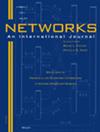群体中心度量优化研究调查
IF 1.3
4区 计算机科学
Q4 COMPUTER SCIENCE, HARDWARE & ARCHITECTURE
引用次数: 0
摘要
中心度量已成为网络科学和优化领域的一个流行概念。多年来,中心性一直被用于在各种环境中分配重要性和识别有影响力的元素,包括交通、基础设施、生物和社交网络等。尽管如此,大多数文献都侧重于节点中心性。最近,与中心度相对应的群体中心度开始引起科学界和实践者的兴趣。识别网络中具有影响力的节点集变得越来越重要。当这些节点集需要诱发某种图案或结构时,这种重要性就更加突出。在本研究中,我们首次从运筹学和优化的角度回顾了群体中心度量。由于过去十年中该领域在运筹学界的快速演变和发展,这一点尤为有趣。我们首先对群体中心性研究如何发展到今天这一步进行了历史回顾。然后,我们将讨论文献中出现的不同结构和主题,以及流行的技术和方法。最后,我们提出了未来工作的可能途径和方向,主要涉及三个领域:(i) 考虑随机性的概率度量和随机优化技术;(ii) 尚未研究的结构和松弛;(iii) 可以利用群体中心性的新兴应用。我们的调查报告简要回顾了分组中心性及其与网络分析和优化的交集。本文章由计算机程序翻译,如有差异,请以英文原文为准。
A survey on optimization studies of group centrality metrics
Centrality metrics have become a popular concept in network science and optimization. Over the years, centrality has been used to assign importance and identify influential elements in various settings, including transportation, infrastructure, biological, and social networks, among others. That said, most of the literature has focused on nodal versions of centrality. Recently, group counterparts of centrality have started attracting scientific and practitioner interest. The identification of sets of nodes that are influential within a network is becoming increasingly more important. This is even more pronounced when these sets of nodes are required to induce a certain motif or structure. In this study, we review group centrality metrics from an operations research and optimization perspective for the first time. This is particularly interesting due to the rapid evolution and development of this area in the operations research community over the last decade. We first present a historical overview of how we have reached this point in the study of group centrality. We then discuss the different structures and motifs that appear prominently in the literature, alongside the techniques and methodologies that are popular. We finally present possible avenues and directions for future work, mainly in three areas: (i) probabilistic metrics to account for randomness along with stochastic optimization techniques; (ii) structures and relaxations that have not been yet studied; and (iii) new emerging applications that can take advantage of group centrality. Our survey offers a concise review of group centrality and its intersection with network analysis and optimization.
求助全文
通过发布文献求助,成功后即可免费获取论文全文。
去求助
来源期刊

Networks
工程技术-计算机:硬件
CiteScore
4.40
自引率
9.50%
发文量
46
审稿时长
12 months
期刊介绍:
Network problems are pervasive in our modern technological society, as witnessed by our reliance on physical networks that provide power, communication, and transportation. As well, a number of processes can be modeled using logical networks, as in the scheduling of interdependent tasks, the dating of archaeological artifacts, or the compilation of subroutines comprising a large computer program. Networks provide a common framework for posing and studying problems that often have wider applicability than their originating context.
The goal of this journal is to provide a central forum for the distribution of timely information about network problems, their design and mathematical analysis, as well as efficient algorithms for carrying out optimization on networks. The nonstandard modeling of diverse processes using networks and network concepts is also of interest. Consequently, the disciplines that are useful in studying networks are varied, including applied mathematics, operations research, computer science, discrete mathematics, and economics.
Networks publishes material on the analytic modeling of problems using networks, the mathematical analysis of network problems, the design of computationally efficient network algorithms, and innovative case studies of successful network applications. We do not typically publish works that fall in the realm of pure graph theory (without significant algorithmic and modeling contributions) or papers that deal with engineering aspects of network design. Since the audience for this journal is then necessarily broad, articles that impact multiple application areas or that creatively use new or existing methodologies are especially appropriate. We seek to publish original, well-written research papers that make a substantive contribution to the knowledge base. In addition, tutorial and survey articles are welcomed. All manuscripts are carefully refereed.
 求助内容:
求助内容: 应助结果提醒方式:
应助结果提醒方式:


